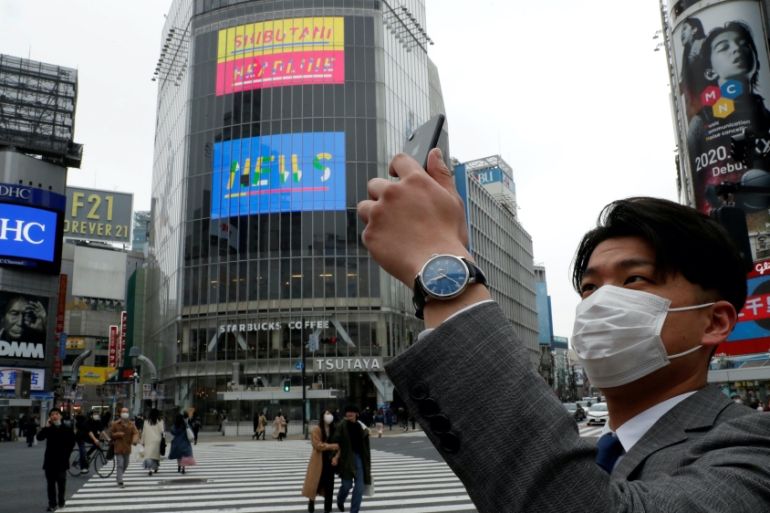‘The good times continue to roll’: Stocks jump on recovery hopes
Investors bet that stimulus measures will help economies rebound quickly, but some analysts warn of more dangers ahead.

Global shares vaulted to a near three-month high on Wednesday as hopes of more stimulus and further easing in social restrictions around the world outweighed caution over a host of worries ranging from more coronavirus outbreaks to growing civil unrest in the United States.
The Pan-European Euro Stoxx 50 index was up 1.22 percent while MSCI’s broadest index of Asia-Pacific shares outside Japan gained 1.8 percent, extending its rally into a fifth straight day to reach a level last seen on March 9.
Keep reading
list of 3 itemsOPEC+ nears oil output cut extension to boost prices: Report
Coronavirus fallout: Asia’s online lenders crushed by bad loans
Japan’s Nikkei rose 1.1 percent to its highest level since late February, as a rapidly weakening yen boosted shares of automakers and other cyclical sectors. Stocks gained despite Japan issuing a stay-home alert late on Tuesday as Tokyo recorded 34 new coronavirus cases, the highest since early May.
Meanwhile, mainland China’s CSI300 rose 0.6 percent to break above its May peak to a 12-week high, and South Korea’s Kospi gained more than 3 percent.
In those three countries, where COVID-19 has been relatively well contained, the indexes have recovered substantially to be only about 5-6 percent below this year’s peaks.
E-mini futures for the US S&P 500 were up 0.2 percent in early Wednesday trade, extending the gains so far this week to 1.4 percent. The tech-heavy Nasdaq index has risen to be just over 2 percent below February’s record peak.
Meanwhile, oil prices climbed more than 1 percent to a near three-month high on optimism that major producers will extend production cuts.
US West Texas Intermediate crude (WTI) gained 2.7 percent to $37.81 per barrel, and Brent crude rose 1.8 percent to $40.27 a barrel.
“The good times continue to roll in risk markets,” Mazen Issa, senior FX strategist at TD Securities, said in a report. “As intense as the rally has been, this is likely set to continue as the breadth of the equity rally has now spread outside the US”
But some analysts warned that economies around the world are still contracting, while unemployment continues to rise and spending to fall.
‘Fantastically naive’
“It appears we have entered a world where, whatever horrors are thrown at the economy, the expectation is that sufficient fiscal and monetary firepower can and will be thrown at the problem to make it go away,” Robert Carnell, head of research for the Asia-Pacific region at Dutch investment bank ING, said in a research note sent to Al Jazeera.
“I think that is a fantastically naive position to take. The next few months should show whether or not I am right,” he added.
MSCI’s gauge of stocks across the globe rose 0.3 percent, hitting a three-month high and extending the gain from its March 23 low to almost 36 percent. Despite pandemic lockdowns that have pushed many economies into contraction, the global index is down year-to-date less than 8 percent.
There are some signs of recovery in business activity as governments restart their economies.
In China, which managed to quash the outbreak by March, a closely-watched survey of service sector activity recovered to pre-epidemic levels in May.
High-frequency data, such as restaurant bookings and mobility data, shows activity is gradually recovering in many developed countries after bottoming out in April, even though a return to pre-epidemic levels still seems far-off.
Some analysts caution, however, that the rally is being driven mostly by short-covering by speculators who had sold stocks earlier on fears of a global recession.
Risks that could hobble the global economy include a second wave of COVID-19 infections, China-US tensions and rising social unrest in the US following protests against police brutality, they said.
“The gap between stock market and the real economy is growing. Many corporate executives must be now wondering why their companies’ shares are rising so much,” said Norihiro Fujito, chief investment strategist at Mitsubishi UFJ Morgan Stanley Securities.
The US Treasury yield curve steepened, partly reflecting the sale of more government debt to finance massive stimulus efforts.
The 30-year US Treasuries yield rose to as high as 1.532 percent, its highest since mid-March. Bond yields rise as their prices fall.
However, expectations of central bank policy support kept shorter yields in check, boosting the yield gap between 5- and 30-year Treasuries to 118 basis points, the highest since early 2017.
The European Central Bank is expected to ramp up stimulative bond purchases when it meets on Thursday, while some analysts say the US Federal Reserve could also enhance its easing measures.
In the currency market, economic optimism supported risk-sensitive currencies and pushed down the US dollar.
The Australian dollar rose as much as 1.2 percent to a five-month high of $0.6982, while the euro ticked up 0.25 percent to $1.1197.
The safe-haven Japanese yen hit a two-month low of 108.85 to the dollar before bouncing back to about 108.57 per dollar.
Spot gold traded almost flat at $1,723 per ounce.